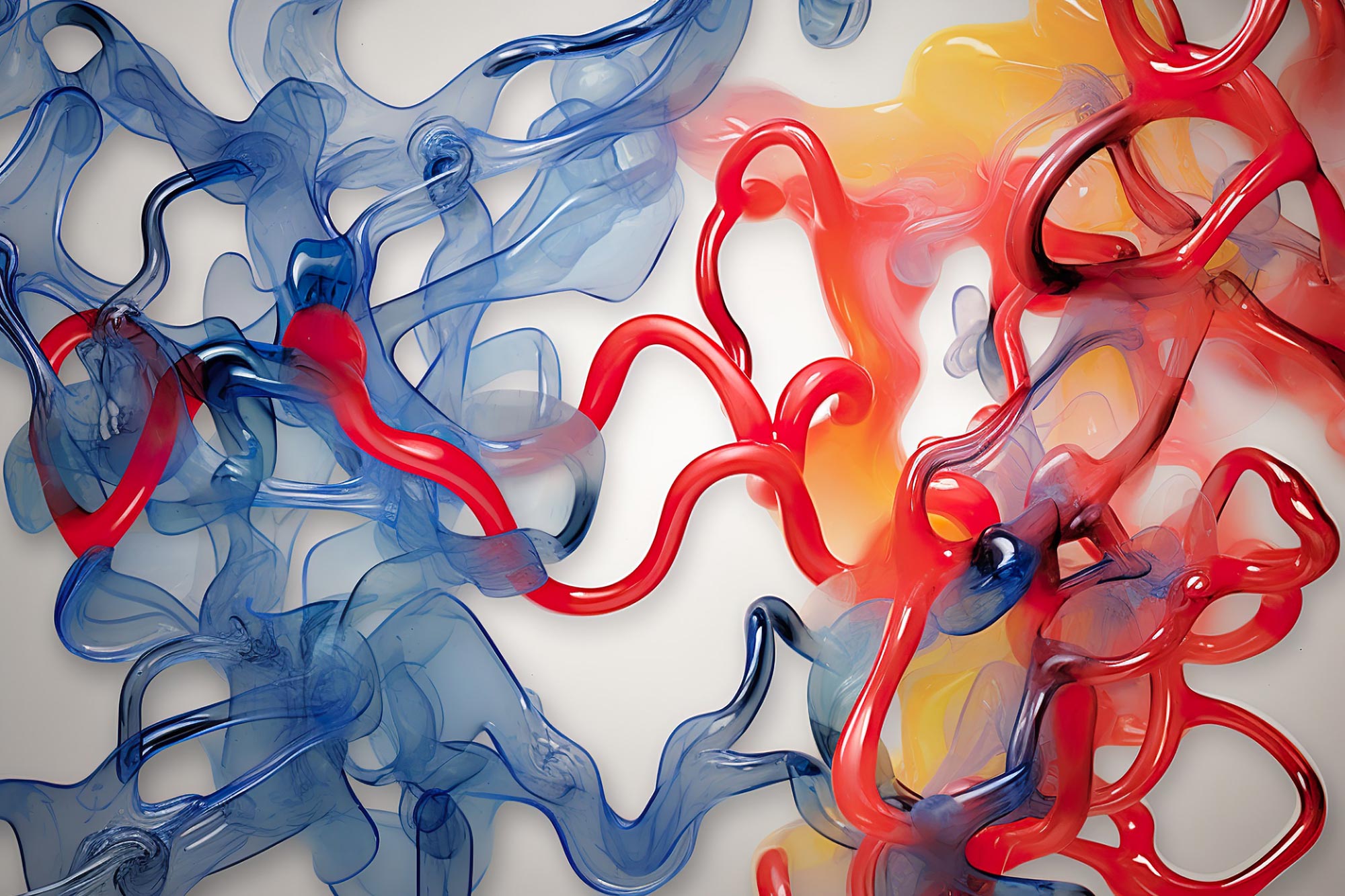
MIT와 듀크 대학의 화학자들은 더 약한 결합을 구조에 통합하여 폴리머의 강도를 10배로 혁신적으로 증가시켰으며, 이는 재료의 다른 물리적 특성을 변경하지 않는 발견입니다. 이 획기적인 발전은 고무 타이어의 수명을 늘리고 미세 플라스틱 폐기물을 줄이는 데 상당한 영향을 미칠 수 있습니다.
폴리머 네트워크에 약한 결합을 추가함으로써 화학자들은 재료의 찢어짐에 대한 저항성을 크게 향상시켰습니다.
MIT와 듀크 대학의 화학자 팀은 폴리머를 더 강하게 만드는 직관에 반하는 방법을 발견했습니다. 즉, 재료에 약한 결합을 도입하는 것입니다.
연구원들은 폴리아크릴레이트 엘라스토머로 알려진 폴리머 유형을 사용하여 일부 폴리머 구성 요소를 결합하기 위해 더 약한 유형의 가교제를 사용함으로써 찢어짐에 대한 재료의 저항성을 최대 10배까지 높일 수 있음을 발견했습니다.
이러한 고무와 같은 폴리머는 자동차 부품에 일반적으로 사용되며 3D 인쇄 개체의 “잉크”로도 자주 사용됩니다. 연구원들은 현재 이 접근 방식을 고무 타이어와 같은 다른 유형의 재료로 확장할 가능성을 탐색하고 있습니다.
Jeremiah Johnson, 화학과 교수[{” attribute=””>MIT and one of the senior authors of the study, which was published on June 22 in the journal Science.

As this polymer network is stretched, weaker crosslinking bonds (blue) break more easily than any of the strong polymer strands, making it more difficult for a crack to propagate through the material. Credit: Courtesy of the researchers, edited by MIT News
A significant advantage of this approach is that it doesn’t appear to alter any of the other physical properties of the polymers.
“Polymer engineers know how to make materials tougher, but it invariably involves changing some other property of the material that you don’t want to change. Here, the toughness enhancement comes without any other significant change in physical properties — at least that we can measure — and it is brought about through the replacement of only a small fraction of the overall material,” says Stephen Craig, a professor of chemistry at Duke University who is also a senior author of the paper.
This project grew out of a longstanding collaboration between Johnson, Craig, and Duke University Professor Michael Rubinstein, who is also a senior author of the paper. The paper’s lead author is Shu Wang, an MIT postdoc who earned his PhD at Duke.
The weakest link
Polyacrylate elastomers are polymer networks made from strands of acrylate held together by linking molecules. These building blocks can be joined together in different ways to create materials with different properties.
One architecture often used for these polymers is a star polymer network. These polymers are made from two types of building blocks: one, a star with four identical arms, and the other a chain that acts as a linker. These linkers bind to the end of each arm of the stars, creating a network that resembles a volleyball net.
In a 2021 study, Craig, Rubinstein, and MIT Professor Bradley Olsen teamed up to measure the strength of these polymers. As they expected, they found that when weaker end-linkers were used to hold the polymer strands together, the material became weaker. Those weaker linkers, which contain cyclic molecules known as cyclobutane, can be broken with much less force than the linkers that are usually used to join these building blocks.
As a follow-up to that study, the researchers decided to investigate a different type of polymer network in which polymer strands are cross-linked to other strands in random locations, instead of being joined at the ends.
This time, when the researchers used weaker linkers to join the acrylate building blocks together, they found that the material became much more resistant to tearing.
This occurs, the researchers believe, because the weaker bonds are randomly distributed as junctions between otherwise strong strands throughout the material, instead of being part of the ultimate strands themselves. When this material is stretched to the breaking point, any cracks propagating through the material try to avoid the stronger bonds and go through the weaker bonds instead. This means the crack has to break more bonds than it would if all of the bonds were the same strength.
“Even though those bonds are weaker, more of them end up needing to be broken, because the crack takes a path through the weakest bonds, which ends up being a longer path,” Johnson says.
Tough materials
Using this approach, the researchers showed that polyacrylates that incorporated some weaker linkers were nine to 10 times harder to tear than polyacrylates made with stronger crosslinking molecules. This effect was achieved even when the weak crosslinkers made up only about 2 percent of the overall composition of the material.
The researchers also showed that this altered composition did not alter any of the other properties of the material, such as resistance to breaking down when heated.
“For two materials to have the same structure and same properties at the network level, but have an almost order of magnitude difference in tearing, is quite rare,” Johnson says.
The researchers are now investigating whether this approach could be used to improve the toughness of other materials, including rubber.
“There’s a lot to explore here about what level of enhancement can be gained in other types of materials and how best to take advantage of it,” Craig says.
Reference: “Facile mechanochemical cycloreversion of polymer cross-linkers enhances tear resistance” by Shu Wang, Yixin Hu, Tatiana B. Kouznetsova, Liel Sapir, Danyang Chen, Abraham Herzog-Arbeitman, Jeremiah A. Johnson, Michael Rubinstein and Stephen L. Craig, 22 June 2023, Science.
DOI: 10.1126/science.adg3229
The group’s work on polymer strength is part of a National Science Foundation-funded center called the Center for the Chemistry of Molecularly Optimized Networks. The mission of this center, directed by Craig, is to study how the properties of the molecular components of polymer networks affect the physical behavior of the networks.

“음악 팬. 매우 겸손한 탐험가. 분석가. 여행 괴짜. 익스트림 TV 전문가. 게이머.”



/cdn.vox-cdn.com/uploads/chorus_asset/file/25619621/247271_Spectacles_2024_NHernandez_Melo_0015.jpg)






